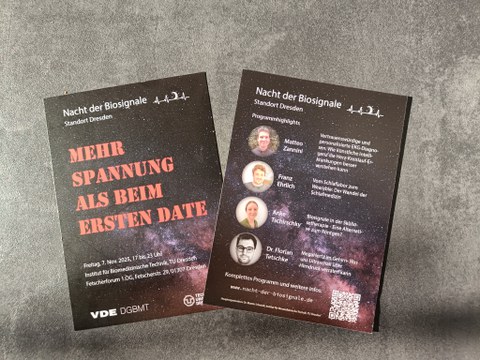Nov 10, 2025
🌙 Between Dream and Technology: Night of Biosignals 2025
On November 7, 2025, TU Dresden opened its doors in the atrium of the Institute of Biomedical Engineering (Fetscherforum, 1st floor, Fetscherstr. 29, 01307 Dresden) for the Dresden edition of the Night of Biosignals.
The Center for Medical Informatics (ZMI) was part of the event:
Our colleague Franz Ehrlich captivated the audience with his talk “From the Sleep Lab to the Wearable: The Transformation of Sleep Medicine”, offering fascinating insights into how AI algorithms accelerate the analysis of sleep data and make diagnostics more efficient.
 © MF/Stephan Wiegand
© MF/Stephan Wiegand
Research fellow
NameMr Dipl.-Inf. Franz Ehrlich
Send encrypted email via the SecureMail portal (for TUD external users only).
Anyone who couldn’t attend in person at the Fetscherforum can rewatch the event online:
🔗 nacht-der-biosignale.de/live-streams/streaming-programm
Research at ZMI: From the Night to the Network of Data
The Center for Medical Informatics focuses on the acquisition, analysis, and application of biosignals – from clinical research to patient-centered care. Two current Medical Informatics Initiative (MII) projects exemplify how data from sleep, heart activity, and everyday life generate new insights:
🌟 Somnolink: Improving diagnosis, treatment, and therapy adherence in obstructive sleep apnea (OSA).
Somnolink is a nationwide, interdisciplinary project bridging sleep medicine and medical informatics. It aims to optimize the patient pathway for OSA by enhancing data availability and applying AI-based analyses to support diagnosis, treatment, and adherence.
💓 ACRIBiS – Personalized Risk Assessment for Cardiovascular Diseases.
ACRIBiS integrates standardized and structured clinical records with biosignal analyses across 15 German partner sites to improve individual risk prediction. The project leverages existing infrastructures from the Medical Informatics Initiative (MII) and the Network University Medicine (NUM) – including Data Integration Centers (DIZ) for data processing and an extended NUM dashboard for centralized monitoring of patient recruitment and evaluation of predictive model performance.

